Template example of resignation letter
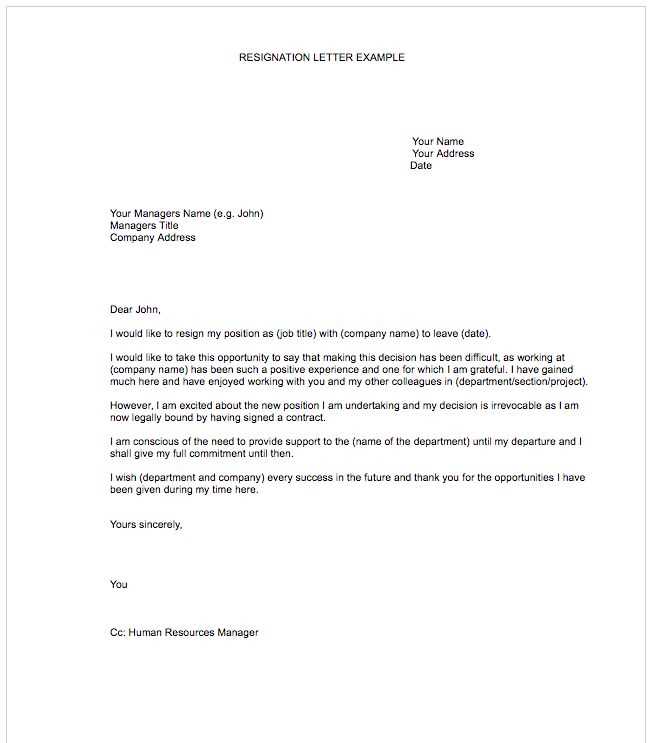
Writing a resignation letter can feel challenging, but it doesn’t have to be complicated. You want to leave on good terms, and a clear, professional resignation letter helps with that. Keep the tone polite, direct, and respectful while explaining your decision to leave. Here’s a simple, effective example to guide you through the process.
A resignation letter should include a few key points: your intention to resign, the date of your last working day, and a brief explanation of your reason for leaving. You don’t need to go into too much detail, but being concise and courteous is important. This letter is a formal document, so treat it as such.
Sample Resignation Letter:
Dear [Manager’s Name],
I am writing to formally resign from my position as [Your Job Title] at [Company Name], effective [Last Working Day]. After careful consideration, I have decided to pursue a new opportunity that aligns with my personal and professional goals.
I am grateful for the support and opportunities provided during my time here. I have enjoyed working with the team and appreciate all the experience gained.
Thank you for understanding, and I hope to stay in touch. Please let me know how I can assist during the transition period.
Sincerely,
[Your Name]
This simple template strikes the right balance of professionalism and gratitude while clearly communicating your intent to resign. Feel free to adjust it to suit your specific situation or company culture.
Here’s the revised version:
Be clear and concise. A resignation letter should express your intention to leave without ambiguity. Begin with a direct statement, such as “I am writing to formally resign from my position as [Job Title] at [Company Name], effective [Date].” This makes your intention clear from the start.
State the Reason Briefly
There’s no need to go into great detail about why you’re leaving, but it can be helpful to offer a brief reason. For example: “I have decided to pursue a new opportunity.” Keep it professional and avoid negative comments about the company, colleagues, or management.
Offer Assistance in the Transition
Show your willingness to help with a smooth transition. A sentence like, “I am happy to assist in the transition process and ensure a handover of my responsibilities” demonstrates professionalism and a desire to leave on good terms.
Finish with gratitude. A simple closing, such as, “Thank you for the opportunity to work with [Company Name],” adds a positive note to the letter. Be sure to sign off formally, using “Sincerely” or “Best regards,” followed by your name.
- Template Example of a Resignation Letter
When drafting a resignation letter, clarity and professionalism are key. Make sure to keep the tone respectful and concise. Below is a template you can adapt to your specific situation:
Dear [Manager’s Name], I am writing to formally resign from my position as [Your Job Title] at [Company Name], effective [Your Last Working Day]. This decision comes after careful consideration, and I believe it is the right time for me to pursue new opportunities. I want to express my gratitude for the support and guidance you have provided during my tenure. Working with the team has been a rewarding experience, and I have gained valuable skills that I will carry with me in the future. I am committed to making this transition as smooth as possible. Please let me know how I can assist with the handover process during my notice period. Thank you once again for the opportunity to be part of [Company Name]. Sincerely, [Your Full Name]
Adjust the placeholders and wording as needed to suit your situation. The goal is to leave on good terms while ensuring a smooth transition for both you and the company.
Adopt a professional but positive tone in your resignation letter. Avoid expressing frustration or resentment, even if your experience at the company wasn’t ideal. Maintain respect and gratitude for the opportunities you’ve had, even if your decision to leave is for personal or professional growth.
Ensure your letter is polite and straightforward. Focus on the future, thanking the company for the experience, and expressing your intention to leave on good terms. Keep the tone appreciative but not overly emotional. This helps maintain professionalism while leaving a lasting positive impression.
While it’s fine to keep things brief, make sure to provide enough context for your departure. If possible, offer assistance with the transition, which shows you are committed to a smooth handover. Keep your language clear and to the point, avoiding long-winded explanations.
Choose words that convey appreciation without being overly formal or distant. A sincere yet cordial tone reflects maturity and respect for both your colleagues and the company, leaving the door open for future opportunities or networking.
Ensure your resignation letter has a clear, professional structure. A well-organized letter not only reflects respect but also helps maintain a positive relationship with your employer.
- Heading: Include your contact information at the top left corner, followed by the date. Then, add the recipient’s name, position, and company address. This helps the reader immediately understand the context and who is sending the letter.
- Salutation: Use a polite greeting, such as “Dear [Manager’s Name].” Keep it formal and professional.
- Opening paragraph: Begin with a clear statement of your resignation, including the position you are leaving and your last working day. This provides immediate clarity and helps your employer plan for your departure.
- Body: Briefly explain your reason for resigning if you feel comfortable. This section should remain polite and positive. Avoid unnecessary details and focus on expressing gratitude for the opportunity to work with the company.
- Closing paragraph: Offer assistance in transitioning your duties, such as helping train a replacement or completing outstanding projects. Show your willingness to make the transition as smooth as possible.
- Sign-off: Close with a formal sign-off such as “Sincerely” or “Best regards,” followed by your full name.
Double-check for typos and clarity before sending. A well-formatted resignation letter leaves a lasting positive impression.
Key Information to Include in Your Resignation Letter
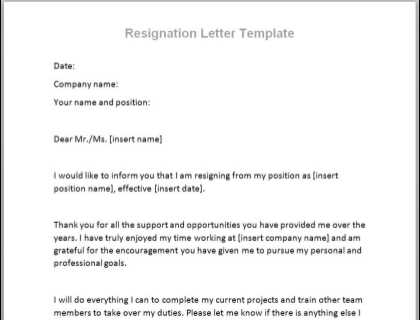
State your intention to resign clearly and concisely. Mention the specific position you’re resigning from, and include your intended last working day. This helps the employer understand your timeline right away. Make sure to review the notice period in your contract, so you can comply with any obligations.
Gratitude and Appreciation
Express appreciation for the opportunities you’ve had. Focus on the positive aspects of your experience without overdoing it. A simple thank you for the growth and skills developed during your time at the company is enough.
Offer Assistance in Transition
Offer your help during the transition period. This could involve training a replacement or completing ongoing projects before you leave. Being helpful shows professionalism and leaves a lasting positive impression.
Begin your resignation letter by addressing your manager with respect. Use their formal title or simply “Dear [Manager’s Name],” to maintain professionalism. If your relationship is informal, feel free to use their first name, but ensure you are still polite and respectful in tone.
Keep It Professional
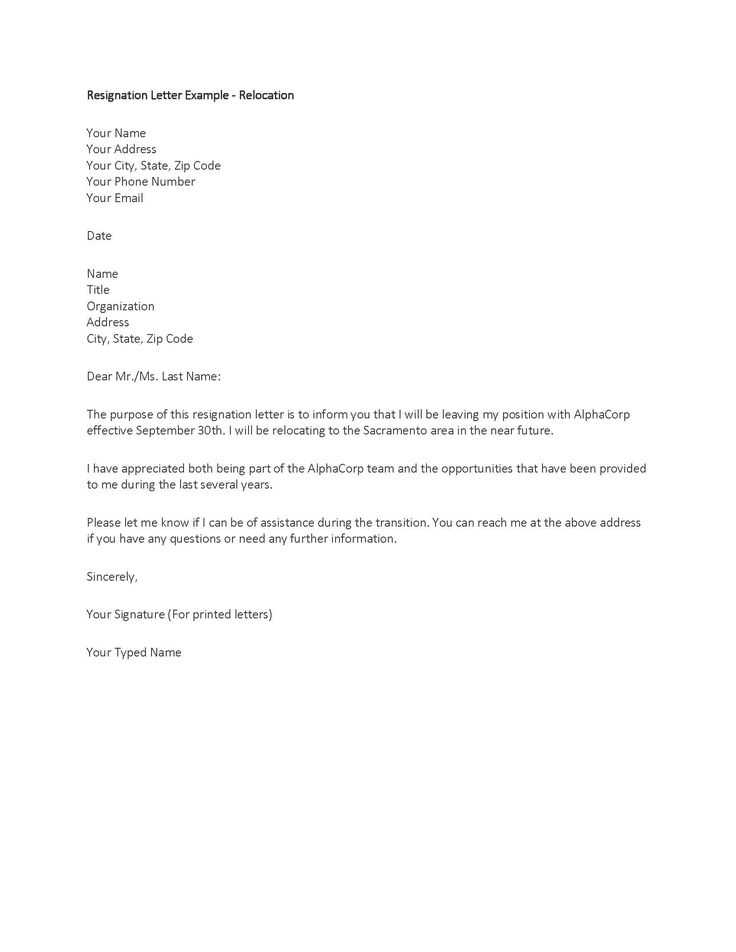
Maintain a professional tone throughout the letter. Avoid overly casual language or humor, as this may not reflect the seriousness of your decision. A concise opening line like, “I am writing to formally resign from my position at [Company Name], effective [Last Working Day],” clearly sets the tone for the rest of the letter.
Avoid Overly Detailed Explanations
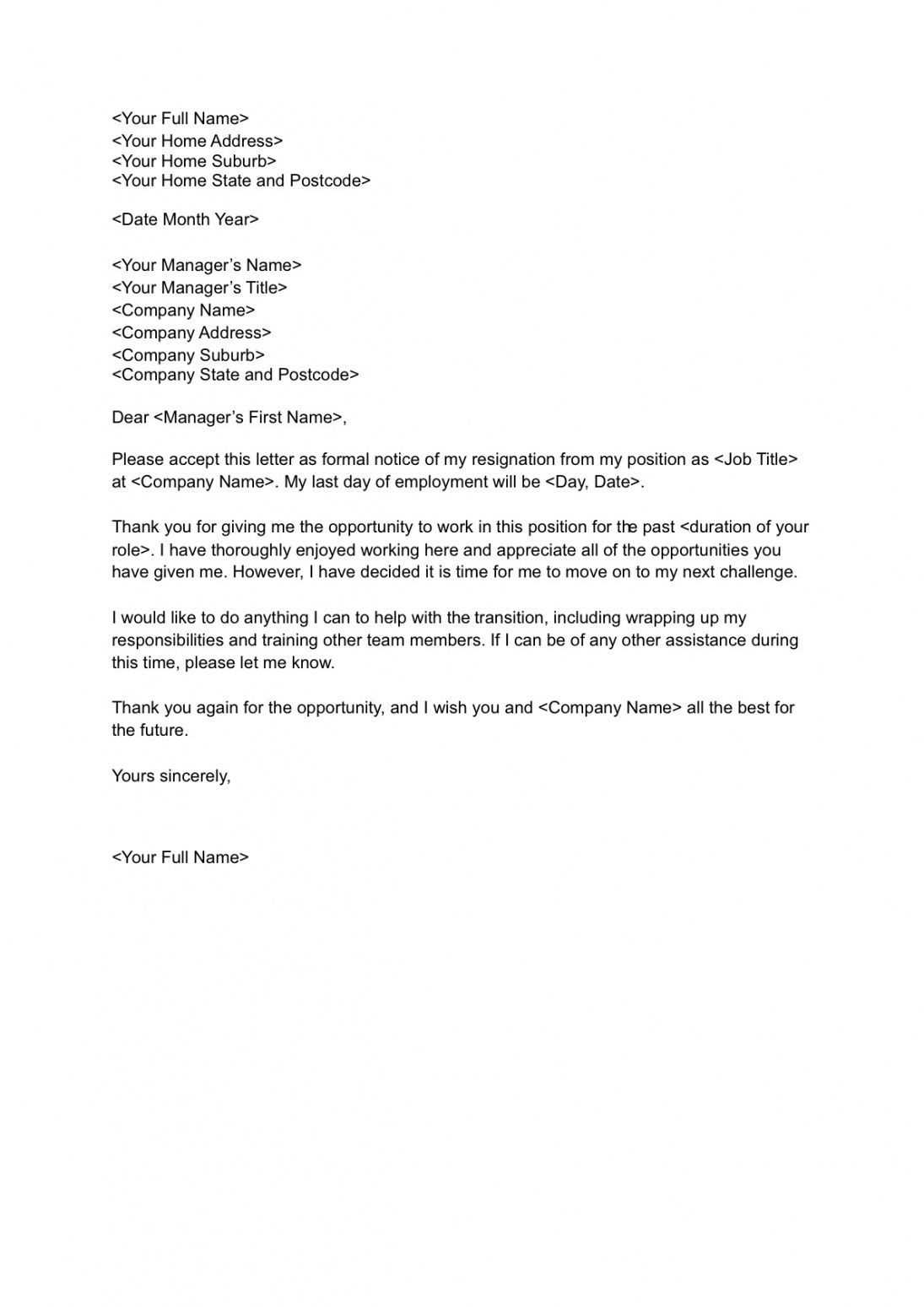
You do not need to provide extensive reasons for your departure. A simple statement that you are resigning for personal or career development reasons is enough. If you do mention reasons, keep them brief and positive. For example, “After careful consideration, I have decided to pursue a new opportunity that aligns with my career goals.” This allows you to remain positive while keeping the focus on your future.
Inform your employer immediately, preferably via email or formal letter, to ensure a written record of your resignation. Be honest and concise about your reasons without over-explaining. Acknowledge the impact your departure might have and express gratitude for the opportunity.
Offer to help during the transition period. If possible, provide assistance in finding a replacement or creating handover notes. This gesture shows goodwill and professionalism, even when leaving unexpectedly.
If feasible, propose a brief transition plan outlining tasks to complete or details for the next person taking over your responsibilities. This helps your employer manage the gap more smoothly.
- Stick to your commitment if you offer help during the transition.
- Be respectful of your employer’s needs and time, even when leaving on short notice.
- Ensure a smooth handover of your projects or ongoing work to minimize disruption.
Maintain a positive tone in all communication. Avoid discussing negative aspects of the job or workplace, as this can damage your professional reputation. A courteous resignation preserves your relationships with colleagues and supervisors, making it easier to stay in touch in the future.
Keep your tone professional and avoid negativity. Complaining about coworkers or management can damage your reputation and future opportunities. Focus on the positive aspects of your time at the company instead.
Don’t forget to include the specific date of your resignation. Leaving out this detail can create confusion or make the process less clear for your employer. Always state your final day of work to ensure clarity.
Avoid vague language. Be clear about your reasons for leaving without going into unnecessary detail. This helps avoid misunderstandings and keeps the letter concise.
Never burn bridges. Even if you’re leaving due to a poor experience, maintain a respectful tone. You may need a reference or encounter your employer again in the future, so always keep the relationship cordial.
Don’t wait until the last minute. Give enough notice as per your contract or company norms. Failing to do so may leave your employer scrambling to fill your position and harm your professional image.
| Common Mistake | Tip to Avoid |
|---|---|
| Negative tone | Keep it respectful and positive |
| Missing the resignation date | Clearly state your final day of work |
| Being too vague | Be direct and clear about your decision |
| Burning bridges | Stay professional and polite |
| Not giving enough notice | Follow your contract’s notice period |
Change of Structure to Avoid Repetitions While Maintaining Meaning
To refine your resignation letter and make it clearer, focus on altering sentence structure. Replacing redundant phrases with varied word choices can make your message stronger and more concise. Ensure that each sentence brings new information without repeating the same concepts unnecessarily.
Use Synonyms to Replace Repetitive Words
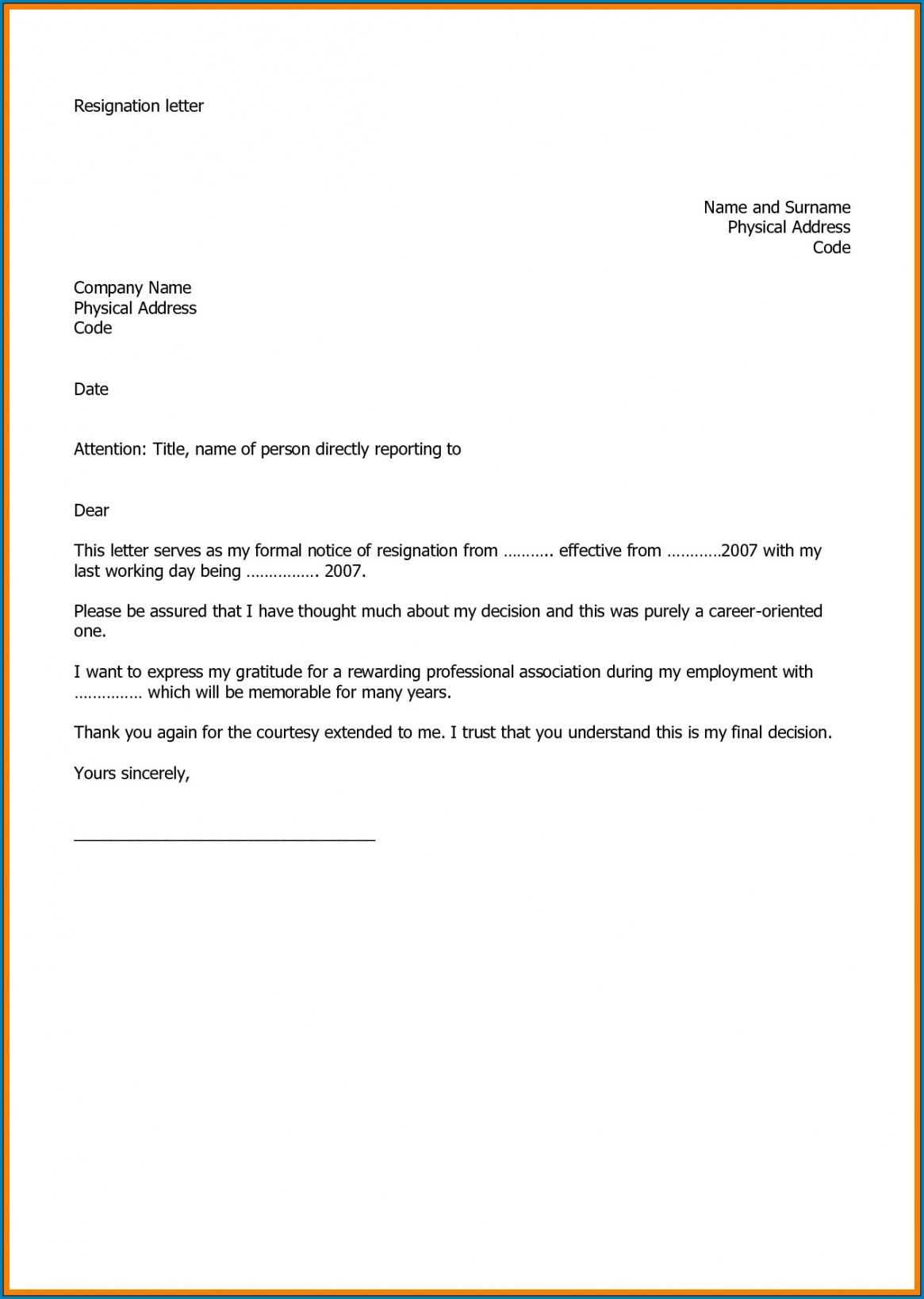
One of the easiest ways to avoid repetition is by using synonyms. For instance, instead of repeating “thank you” multiple times, consider using “I appreciate” or “I am grateful for.” This simple swap keeps your writing fresh and prevents overused expressions.
Rearrange Sentences to Improve Flow
Another effective strategy is to rearrange the order of your sentences. By changing the sequence, you can emphasize different points and maintain a smooth flow. For example, start with your gratitude, then proceed to the explanation of your decision. This approach helps to structure your thoughts logically.
By implementing these techniques, you can refine your letter without losing its original meaning.